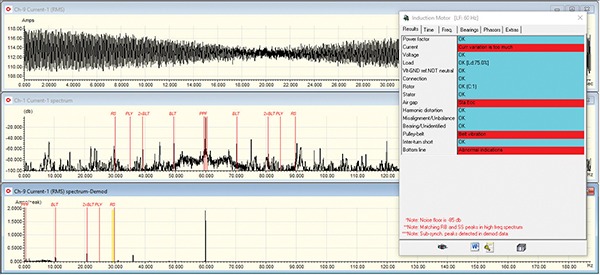Belt Tension Matters
EP Editorial Staff | May 1, 2023
By Howard W. Penrose, PhD, CMRP, MotorDoc LLC
As we continue to review the impact of electric-motor-system reliability and maintenance on energy and emissions, some of the most common types of commercial and industrial applications are belted fans. These can represent as much as 21% of all electric-motor applications and have a very specific issue: They tend to be over tensioned versus under tensioned. If there is turbulence, the belt may vibrate and, when over tensioned, the bearings act as pivot points causing the rotor to pull toward one side. The resulting unbalanced magnetic pull shows as static eccentricity and increases the losses associated with the application. The additional friction on the belts also causes additional energy losses. These are measurable in Electrical Signature Analysis (ESA) and detectable in energy and emissions.
Figure 1: Findings on a 125-hp motor and fan.
In this example we have a 125-hp, 1,780-rpm electric motor at 75% load and 70 kW input with a current unbalance and high circuit impedance unbalance (loose connection). Some static eccentricity, belt, and belt vibration losses are detected at a total of 1.35 kW static eccentricity losses (Fig. 2) and 1.25 kW belt losses. We will use 6,000 hr./yr. operation at an average of this load, $10/kW demand, and $0.10/kWh.
Figure 2: Kilowatt losses due to unbalance magnetic pull (static eccentricity)
Figure 3: Kilowatt losses due to belt tension and vibration.
The average demand due to defects is 2.6 kW and the usage is 2.6 kW x 6,000 hr. for 15,600 kWh/yr. consumption. Additional energy costs include $312 demand and $1,500 usage for $1,812 energy and 15.6 MWh x 0.707 metric tonnes CO2/MWh for 11 metric tonnes CO2/yr. due to improper belt tension. At this point, with this machine, the bearing losses are still very low, so significant bearing damage can be avoided by correctly tensioning the belts. The overall losses represent 3.7% of this application.
Howard W. Penrose, PhD, CMRP, is president of MotorDoc LLC, Lombard, IL (motordoc.com). He chairs the wind-power standards and government relations participation for American Clean Power (ACP/AWEA), holds various IEEE standards positions, and is a past chair of SMRP. Reach him at info@motordoc.com.












View Comments